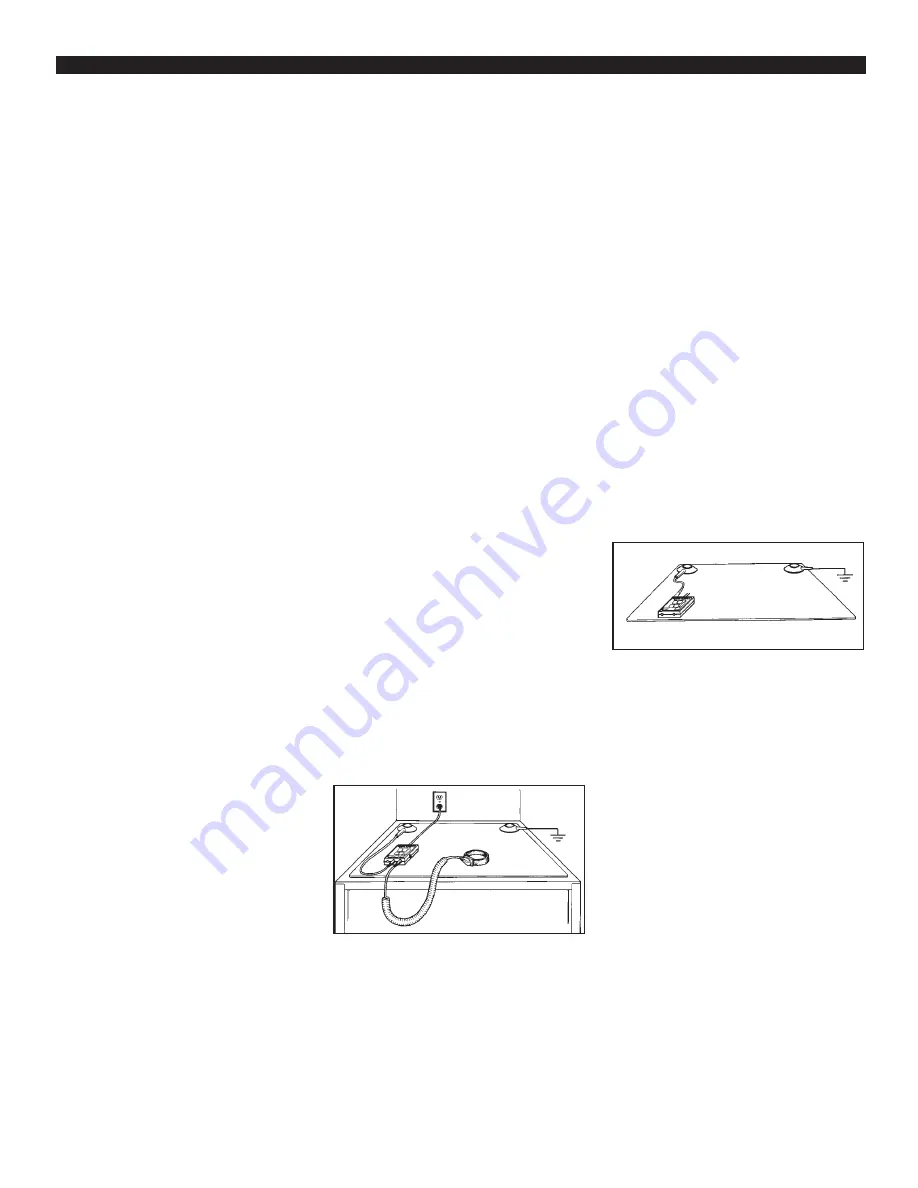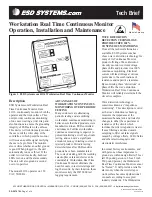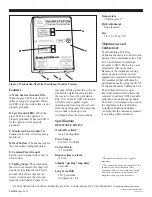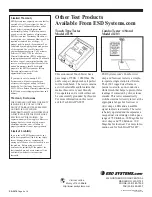
By using the reliable wave distortion
technology to determine if the circuit
is complete, there are no false alarms.
There is no need to adjust or tune the
monitor to a specific user or
installation. The miniscule amount of
electrical current (less than 1 volt coil
cord signal) required to generate the
waveform has never caused reported
skin irritation and is extremely safe
for use in voltage sensitive
applications such as disk drive
manufacturing.
Installation
Remove the Monitor from the carton
and inspect for shipping damage.
Confirm that worksurface RTG
(surface resistance) is 5 x 10
8
or less.
Each unit should include the
following:
1 41116 monitor
1 attached power cord
1 mat monitor cord
1 12102 push & clinch snap
The Workstation Real Time
Continuous Monitor may be mounted
in a convenient position using
pressure-sensitive two piece hook and
loop fastener which is supplied. It is
normally mounted toward the front
edge of a workstation where the LEDs
are easily visible.
Figure 2. Installation of the 41116.
Unit is shown as it is worn by the
operator.
Operation
When the monitor is first plugged into
a properly wired electrical outlet, both
PS-2076
Page 2 of 4
Real Time Continuous Monitor is
drift-free and designed to be
insensitive to the effects of squeezing
or stretching the coil cord.
ADVANTAGES OF WAVE
DISTORTION AND SINGLE-
WIRE TECHNOLOGY
The ESD Systems.com Workstation
Real Time Continuous Monitor allows
the use of any standard, single-wire
wrist strap and coil cord. The
monitor/wrist strap/cord system life-
cycle costs are by far lower than
alternative systems which require
expensive and fragile dual-wire cords
and special wrist straps. Dual-wire
cords are expensive and are the weak
link of the system, the most likely
component to need replacement. Over
a five year period, this can make the
dual-wire system three to five times as
expensive as a system utilizing single-
wire wrist straps and cords.
The dictionary defines constant as
uniform and unchanging, and
continuous as uninterrupted. None-
theless, some dual-wire resistance
monitors utilize a pulsed test current
and do not really provide continuous
monitoring. For example, during each
2.2 second pulse cycle of a leading
“constant” resistive monitor, electrical
current is pulsed for only 0.2 seconds
followed by an unmonitored interval
of 2 seconds. This leaves the
user/wrist strap unmonitored for over
90% of each cycle. Damaging static
charges can easily occur in the portion
of the time in between the pulses. The
off period of 2 seconds equals 2
billion nanoseconds, and “it takes only
about 25 volts applied for 100
nanoseconds to blow most memories
or microprocessors”.* The dual-wire
system does not reliably meet all
industry specifications, as the cords do
not meet the EOS/ESD Association
guidelines for the 1 to 5 pound
“breakaway force” requirement for
operator safety.
red LEDs will light and the alarm will
sound.† The alarm will be sounding at
this time since no wrist strap wearer
or work surface is hooked up.
With a wrist strap on the wrist and the
coil cord attached to the band, plug
the banana plug of the wrist strap
ground into the banana jack marked
“User”. This will cause the operator
green LED to light if the wrist strap is
functioning properly.
Now connect a mat ground cord to the
work surface. (NOTE: The work
surface should be already grounded
with another mat ground cord.) Plug
the banana plug of the mat ground
cord (ESD Systems.com Item #13258)
into the banana jack marked “Work
Surface” (See Figure 3). This will
cause the “Work Surface” green LED
to light if the work surface is properly
grounded.
Figure 3. Installing ground cords on
the work surface.
The user may disconnect the coil cord
from the wrist band and leave the
workstation by first touching the
Standby Snap. This deactivates the
alarm for six seconds and allows the
operator to attach the coil cord to the
Standby Snap. Using this procedure,
the alarm will not sound, which
otherwise could be interpreted as a
problem. Note that if the coil cord is
removed from the wrist band and not
placed on the Standby Snap within six
seconds, the alarm will sound.
†The Workstation Real Time Continuous Monitor
takes 6 seconds to activate its alarm circuitry
when it is first plugged in.
*1981 article by Donald E. Frank - Electrical
Overstress Electronic Discharge Symposium
Proceedings
© 2006 DESCO INDUSTRIES INC.
Employee Owned
432 NORTHBORO ROAD CENTRAL • MARLBORO, MA 01752 • PHONE (508) 485-7390 • FAX (508) 480-0257 • http://www.esdsystems.com






















